LINCOLN TOWN CAR 1998 Owners Manual
Manufacturer: LINCOLN, Model Year: 1998, Model line: TOWN CAR, Model: LINCOLN TOWN CAR 1998Pages: 188, PDF Size: 1.29 MB
Page 171 of 188
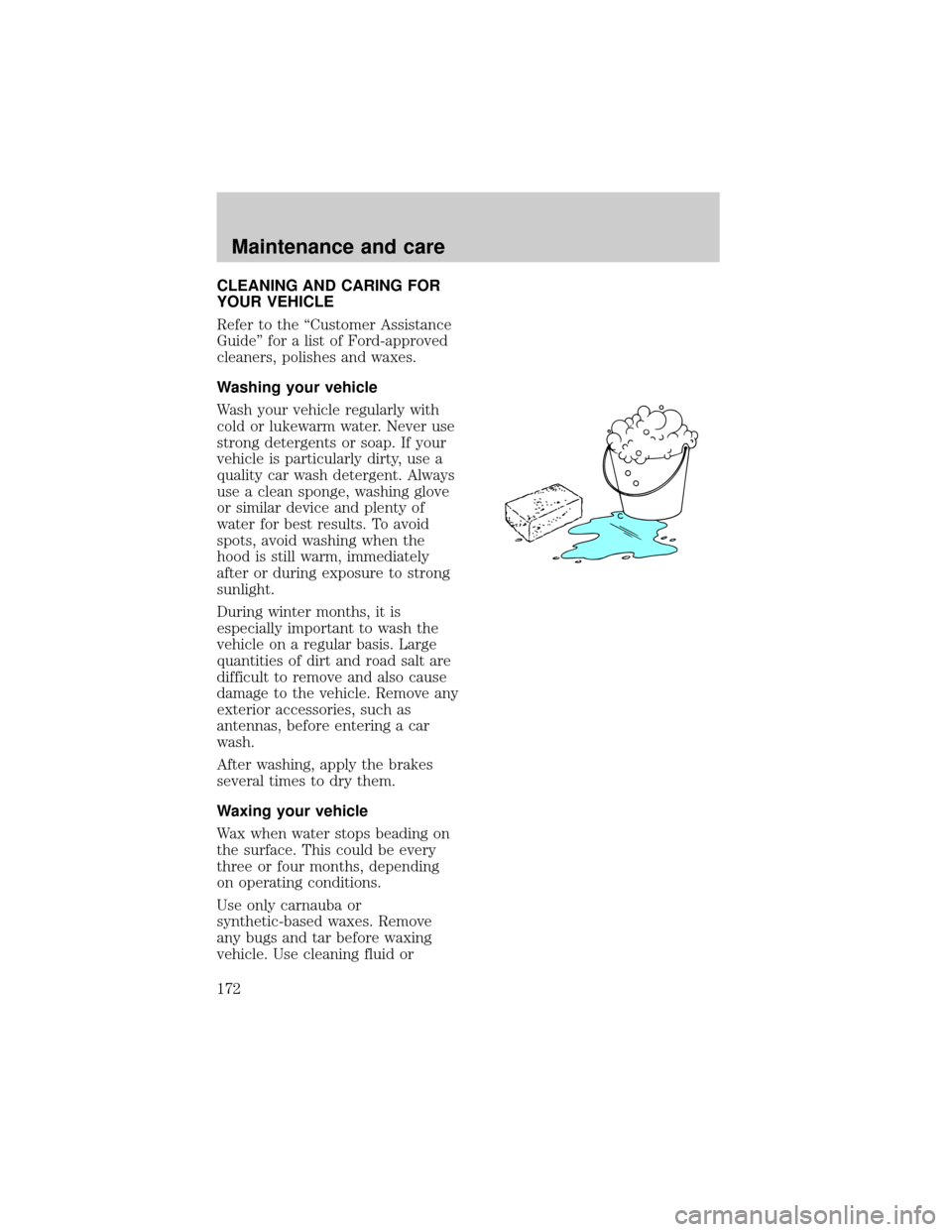
CLEANING AND CARING FOR
YOUR VEHICLE
Refer to the ªCustomer Assistance
Guideº for a list of Ford-approved
cleaners, polishes and waxes.
Washing your vehicle
Wash your vehicle regularly with
cold or lukewarm water. Never use
strong detergents or soap. If your
vehicle is particularly dirty, use a
quality car wash detergent. Always
use a clean sponge, washing glove
or similar device and plenty of
water for best results. To avoid
spots, avoid washing when the
hood is still warm, immediately
after or during exposure to strong
sunlight.
During winter months, it is
especially important to wash the
vehicle on a regular basis. Large
quantities of dirt and road salt are
difficult to remove and also cause
damage to the vehicle. Remove any
exterior accessories, such as
antennas, before entering a car
wash.
After washing, apply the brakes
several times to dry them.
Waxing your vehicle
Wax when water stops beading on
the surface. This could be every
three or four months, depending
on operating conditions.
Use only carnauba or
synthetic-based waxes. Remove
any bugs and tar before waxing
vehicle. Use cleaning fluid or
Maintenance and care
172
Page 172 of 188
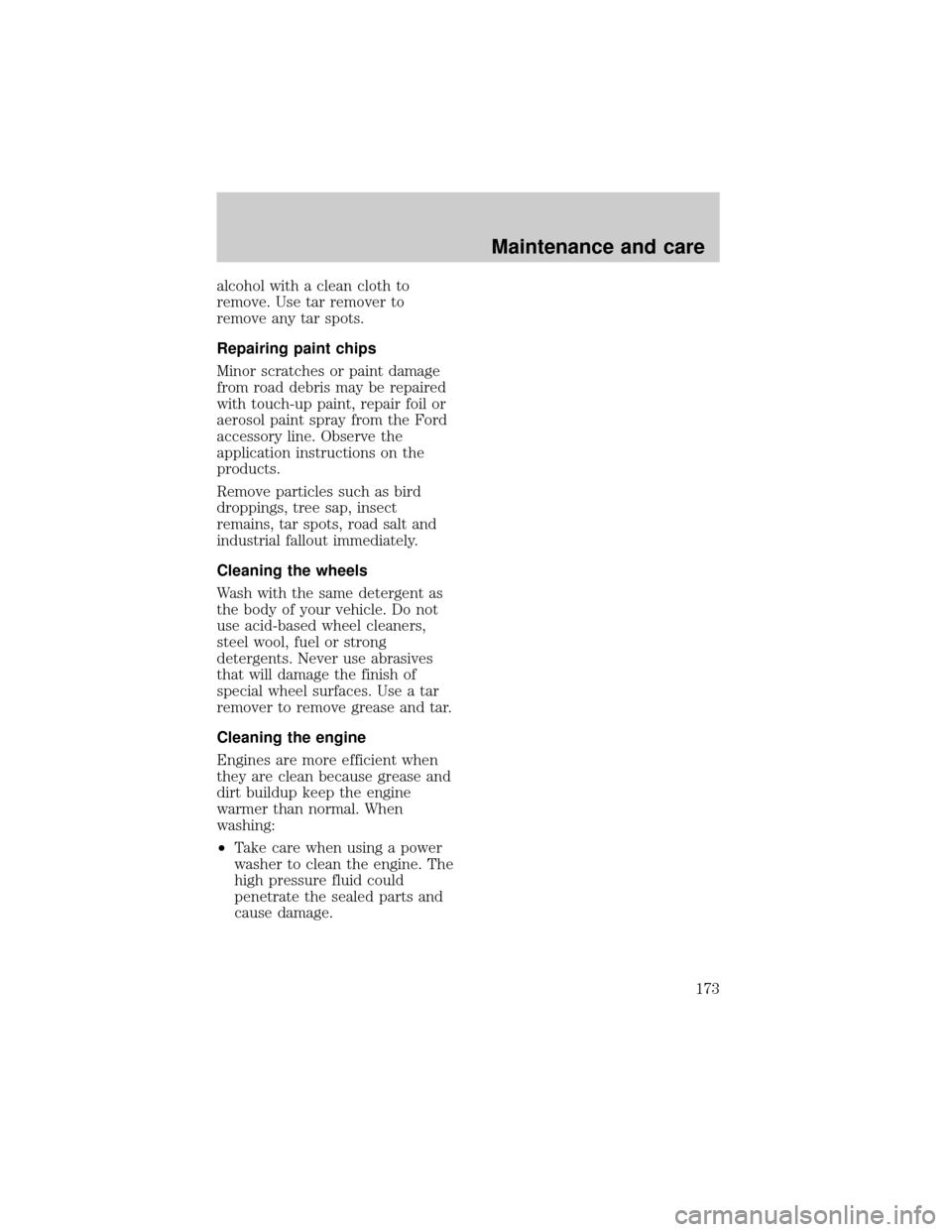
alcohol with a clean cloth to
remove. Use tar remover to
remove any tar spots.
Repairing paint chips
Minor scratches or paint damage
from road debris may be repaired
with touch-up paint, repair foil or
aerosol paint spray from the Ford
accessory line. Observe the
application instructions on the
products.
Remove particles such as bird
droppings, tree sap, insect
remains, tar spots, road salt and
industrial fallout immediately.
Cleaning the wheels
Wash with the same detergent as
the body of your vehicle. Do not
use acid-based wheel cleaners,
steel wool, fuel or strong
detergents. Never use abrasives
that will damage the finish of
special wheel surfaces. Use a tar
remover to remove grease and tar.
Cleaning the engine
Engines are more efficient when
they are clean because grease and
dirt buildup keep the engine
warmer than normal. When
washing:
²Take care when using a power
washer to clean the engine. The
high pressure fluid could
penetrate the sealed parts and
cause damage.
Maintenance and care
173
Page 173 of 188
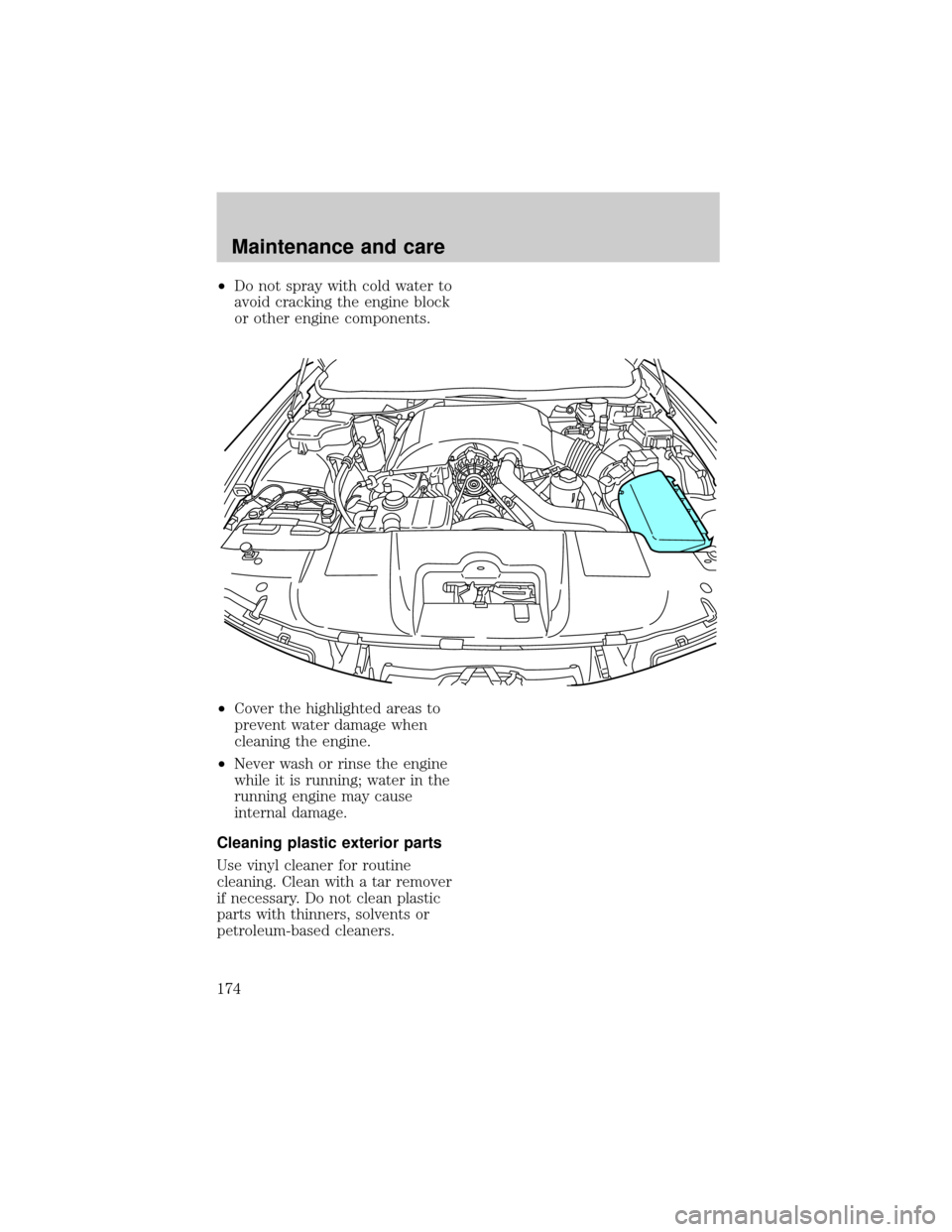
²Do not spray with cold water to
avoid cracking the engine block
or other engine components.
²Cover the highlighted areas to
prevent water damage when
cleaning the engine.
²Never wash or rinse the engine
while it is running; water in the
running engine may cause
internal damage.
Cleaning plastic exterior parts
Use vinyl cleaner for routine
cleaning. Clean with a tar remover
if necessary. Do not clean plastic
parts with thinners, solvents or
petroleum-based cleaners.
Maintenance and care
174
Page 174 of 188
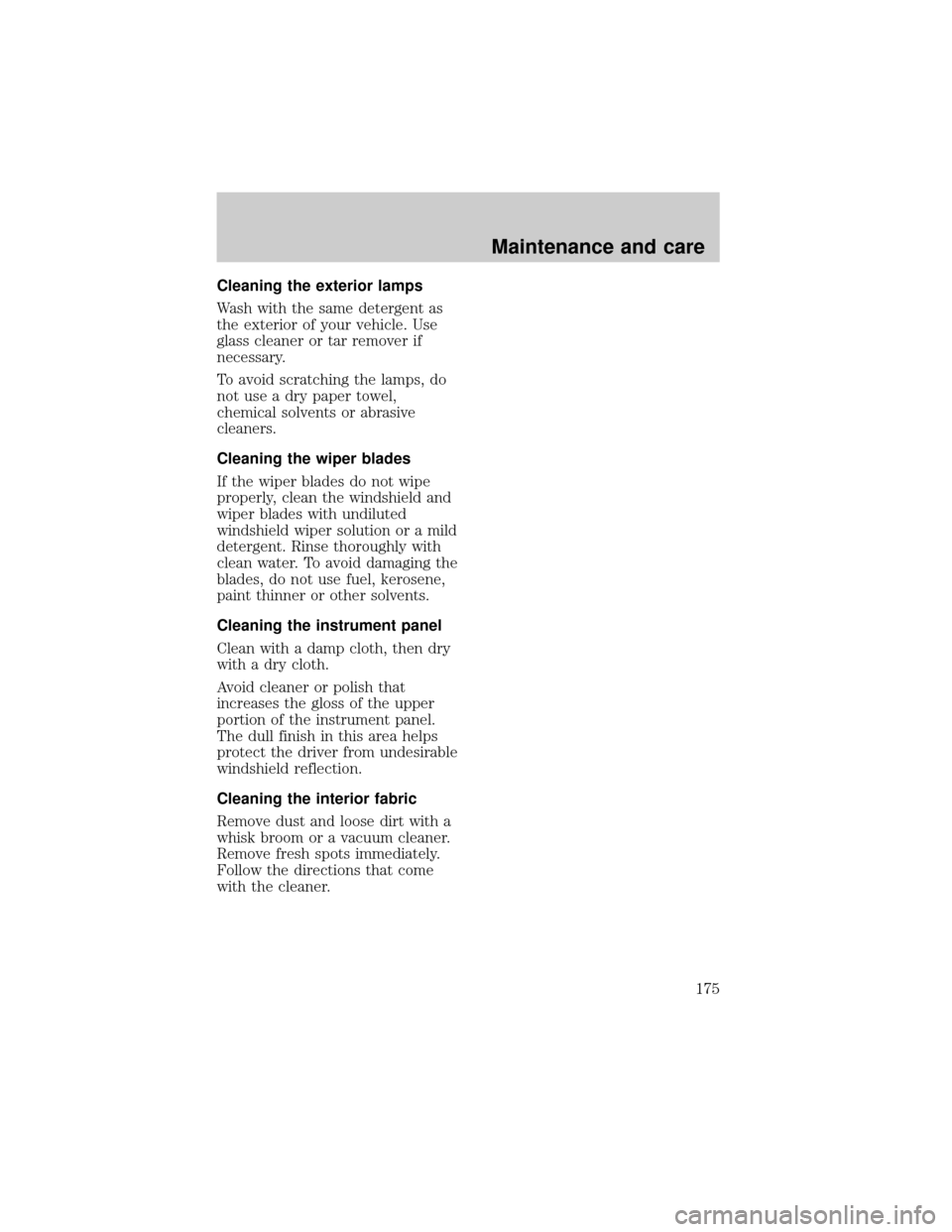
Cleaning the exterior lamps
Wash with the same detergent as
the exterior of your vehicle. Use
glass cleaner or tar remover if
necessary.
To avoid scratching the lamps, do
not use a dry paper towel,
chemical solvents or abrasive
cleaners.
Cleaning the wiper blades
If the wiper blades do not wipe
properly, clean the windshield and
wiper blades with undiluted
windshield wiper solution or a mild
detergent. Rinse thoroughly with
clean water. To avoid damaging the
blades, do not use fuel, kerosene,
paint thinner or other solvents.
Cleaning the instrument panel
Clean with a damp cloth, then dry
with a dry cloth.
Avoid cleaner or polish that
increases the gloss of the upper
portion of the instrument panel.
The dull finish in this area helps
protect the driver from undesirable
windshield reflection.
Cleaning the interior fabric
Remove dust and loose dirt with a
whisk broom or a vacuum cleaner.
Remove fresh spots immediately.
Follow the directions that come
with the cleaner.
Maintenance and care
175
Page 175 of 188
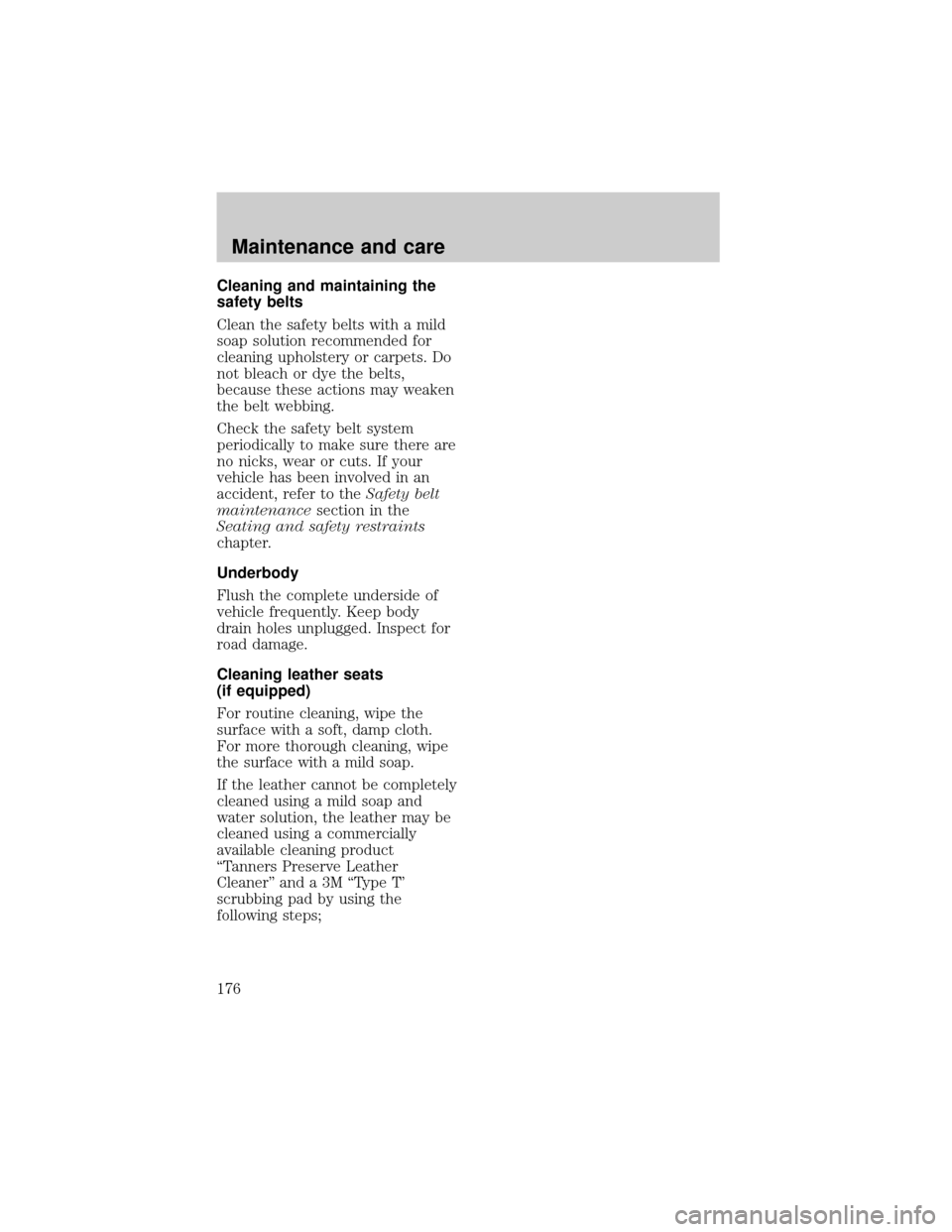
Cleaning and maintaining the
safety belts
Clean the safety belts with a mild
soap solution recommended for
cleaning upholstery or carpets. Do
not bleach or dye the belts,
because these actions may weaken
the belt webbing.
Check the safety belt system
periodically to make sure there are
no nicks, wear or cuts. If your
vehicle has been involved in an
accident, refer to theSafety belt
maintenancesection in the
Seating and safety restraints
chapter.
Underbody
Flush the complete underside of
vehicle frequently. Keep body
drain holes unplugged. Inspect for
road damage.
Cleaning leather seats
(if equipped)
For routine cleaning, wipe the
surface with a soft, damp cloth.
For more thorough cleaning, wipe
the surface with a mild soap.
If the leather cannot be completely
cleaned using a mild soap and
water solution, the leather may be
cleaned using a commercially
available cleaning product
ªTanners Preserve Leather
Cleanerº and a 3M ªType T'
scrubbing pad by using the
following steps;
Maintenance and care
176
Page 176 of 188
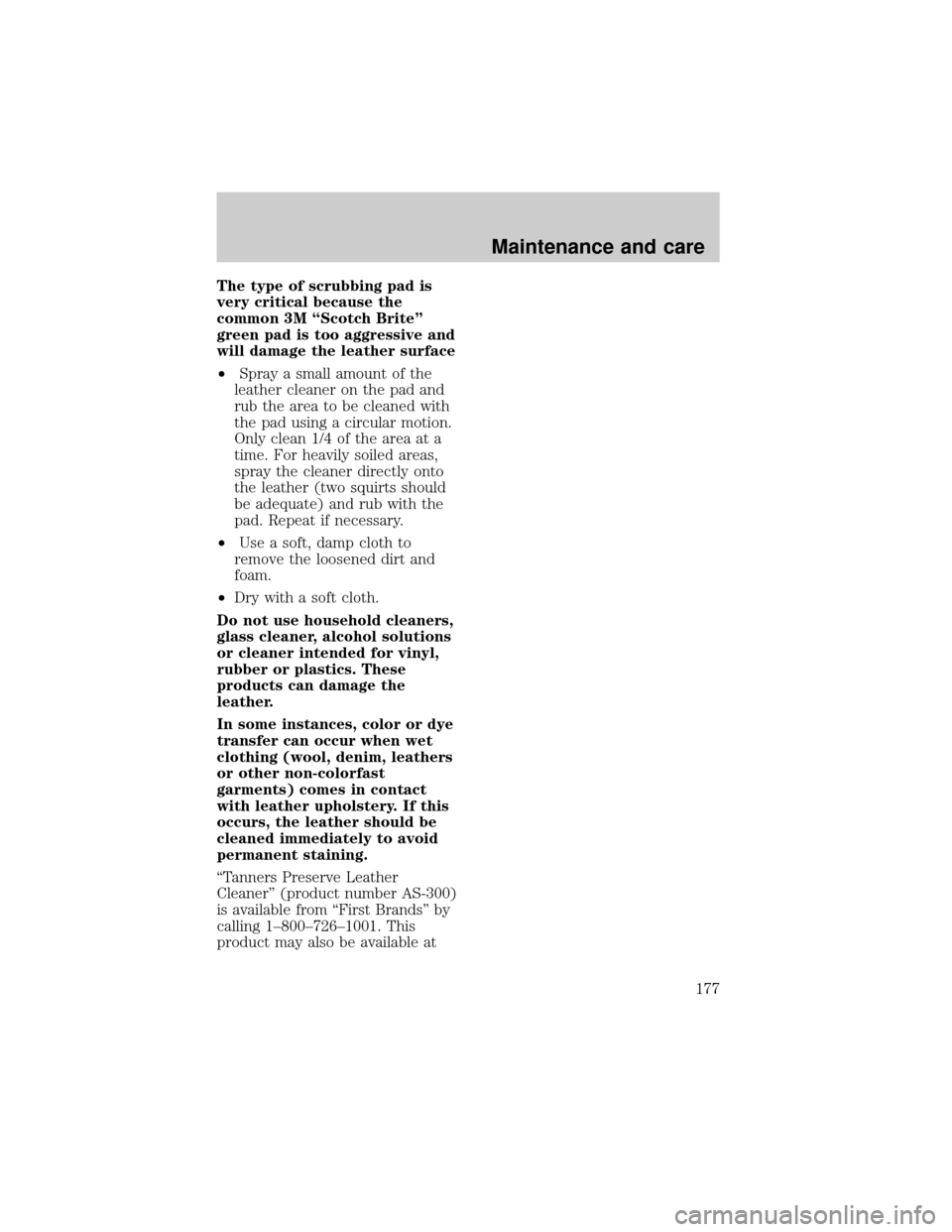
The type of scrubbing pad is
very critical because the
common 3M ªScotch Briteº
green pad is too aggressive and
will damage the leather surface
²Spray a small amount of the
leather cleaner on the pad and
rub the area to be cleaned with
the pad using a circular motion.
Only clean 1/4 of the area at a
time. For heavily soiled areas,
spray the cleaner directly onto
the leather (two squirts should
be adequate) and rub with the
pad. Repeat if necessary.
²Use a soft, damp cloth to
remove the loosened dirt and
foam.
²Dry with a soft cloth.
Do not use household cleaners,
glass cleaner, alcohol solutions
or cleaner intended for vinyl,
rubber or plastics. These
products can damage the
leather.
In some instances, color or dye
transfer can occur when wet
clothing (wool, denim, leathers
or other non-colorfast
garments) comes in contact
with leather upholstery. If this
occurs, the leather should be
cleaned immediately to avoid
permanent staining.
ªTanners Preserve Leather
Cleanerº (product number AS-300)
is available from ªFirst Brandsº by
calling 1±800±726±1001. This
product may also be available at
Maintenance and care
177
Page 177 of 188
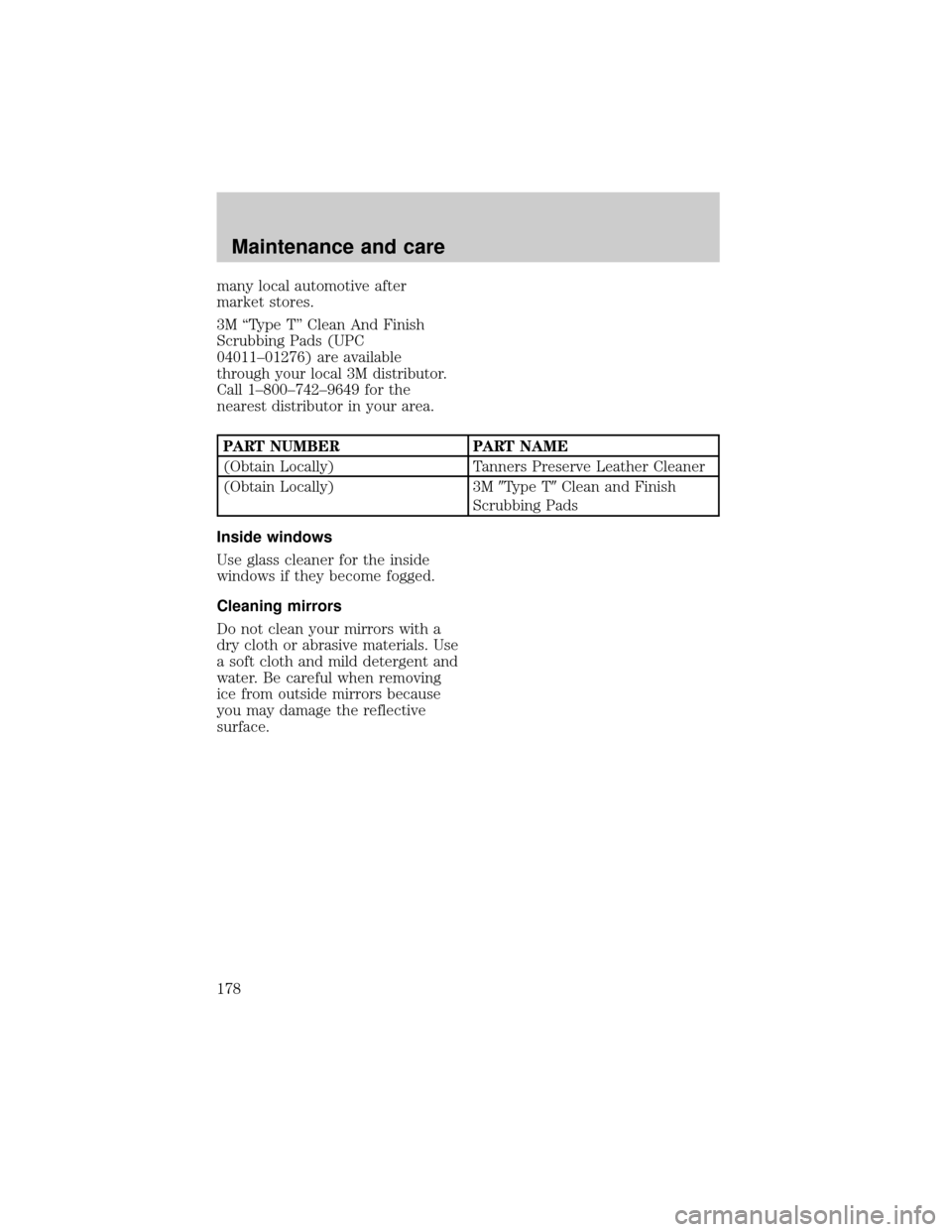
many local automotive after
market stores.
3M ªType Tº Clean And Finish
Scrubbing Pads (UPC
04011±01276) are available
through your local 3M distributor.
Call 1±800±742±9649 for the
nearest distributor in your area.
PART NUMBER PART NAME
(Obtain Locally) Tanners Preserve Leather Cleaner
(Obtain Locally) 3M9Type T9Clean and Finish
Scrubbing Pads
Inside windows
Use glass cleaner for the inside
windows if they become fogged.
Cleaning mirrors
Do not clean your mirrors with a
dry cloth or abrasive materials. Use
a soft cloth and mild detergent and
water. Be careful when removing
ice from outside mirrors because
you may damage the reflective
surface.
Maintenance and care
178
Page 178 of 188
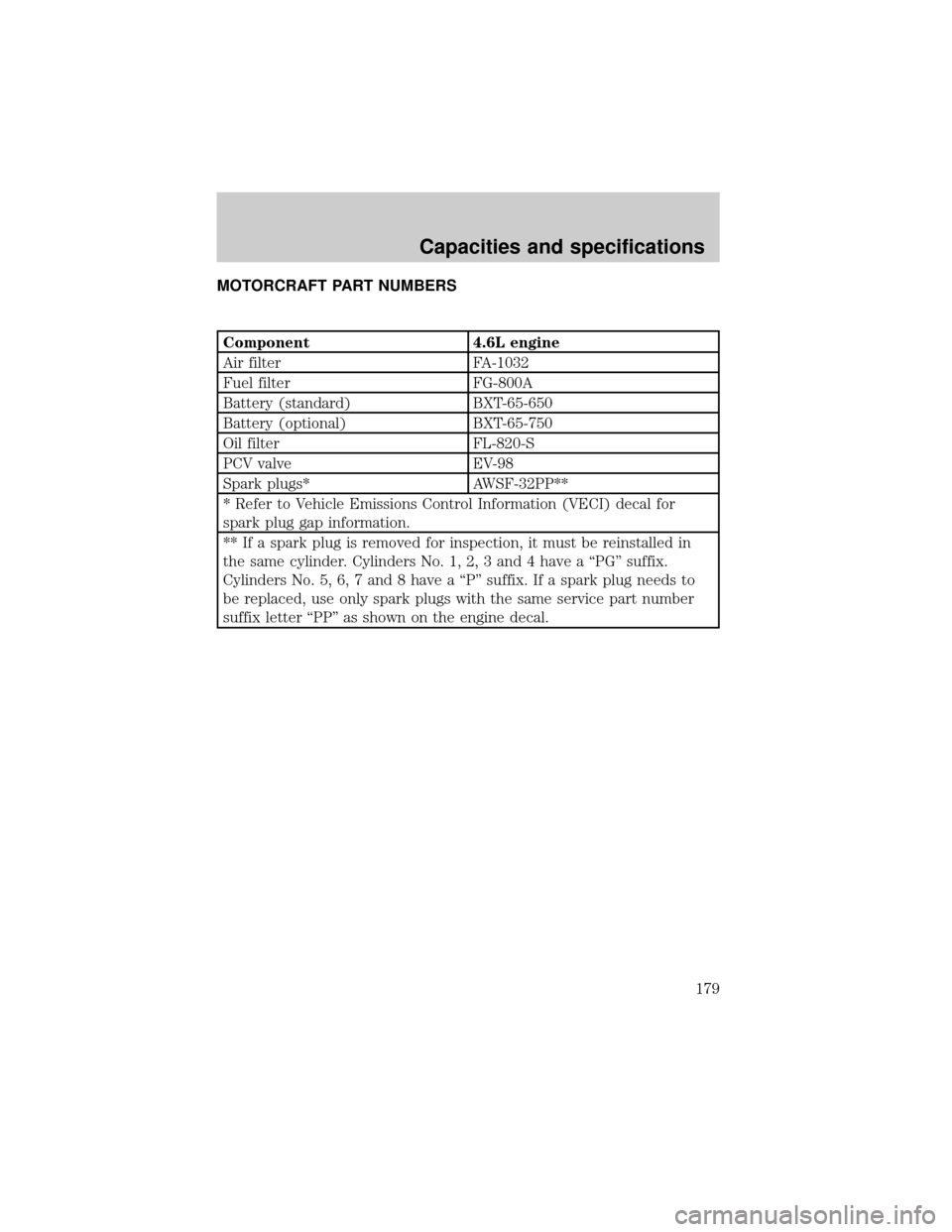
MOTORCRAFT PART NUMBERS
Component 4.6L engine
Air filter FA-1032
Fuel filter FG-800A
Battery (standard) BXT-65-650
Battery (optional) BXT-65-750
Oil filter FL-820-S
PCV valve EV-98
Spark plugs* AWSF-32PP**
* Refer to Vehicle Emissions Control Information (VECI) decal for
spark plug gap information.
** If a spark plug is removed for inspection, it must be reinstalled in
the same cylinder. Cylinders No. 1, 2, 3 and 4 have a ªPGº suffix.
Cylinders No. 5, 6, 7 and 8 have a ªPº suffix. If a spark plug needs to
be replaced, use only spark plugs with the same service part number
suffix letter ªPPº as shown on the engine decal.
Capacities and specifications
179
Page 179 of 188
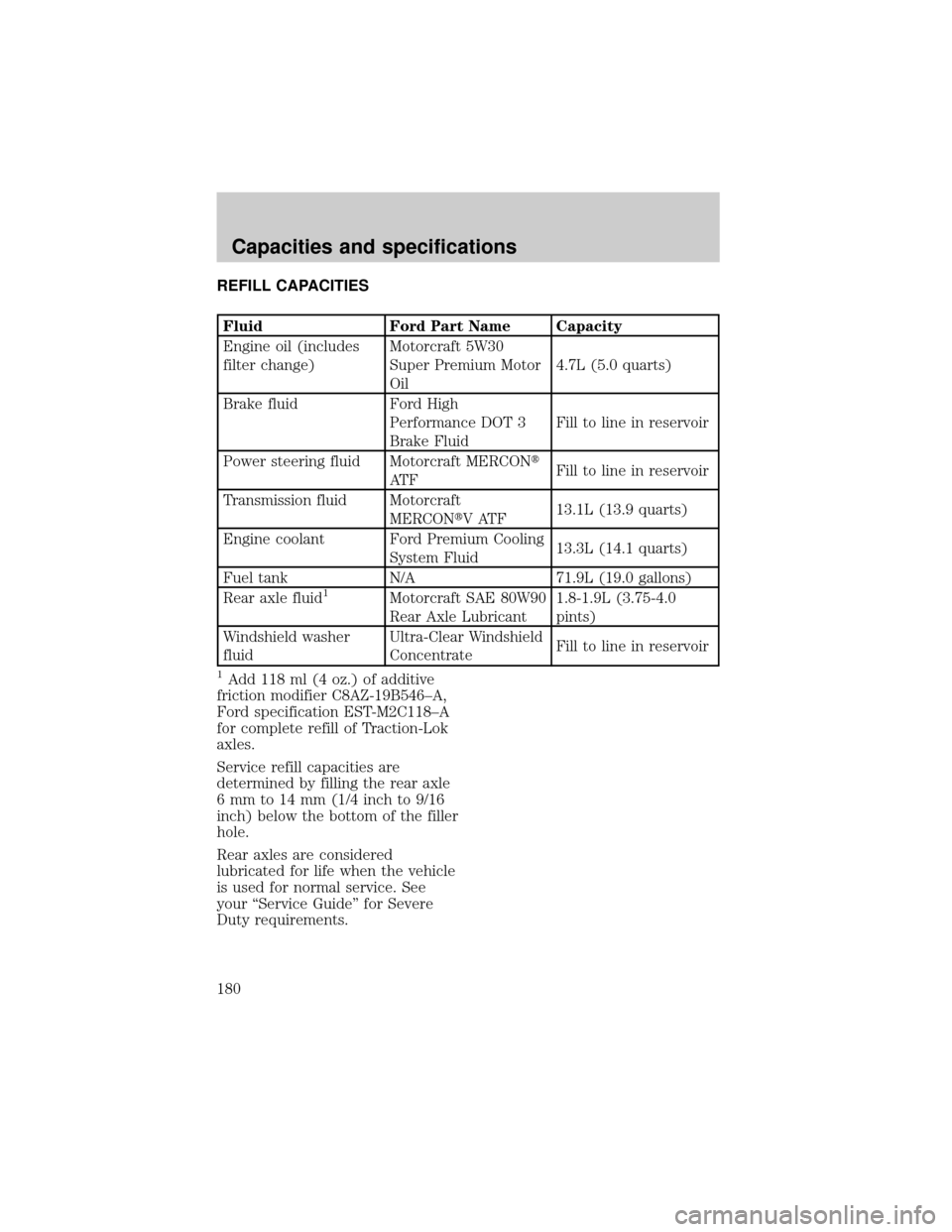
REFILL CAPACITIES
Fluid Ford Part Name Capacity
Engine oil (includes
filter change)Motorcraft 5W30
Super Premium Motor
Oil4.7L (5.0 quarts)
Brake fluid Ford High
Performance DOT 3
Brake FluidFill to line in reservoir
Power steering fluid Motorcraft MERCONt
AT FFill to line in reservoir
Transmission fluid Motorcraft
MERCONtVATF13.1L (13.9 quarts)
Engine coolant Ford Premium Cooling
System Fluid13.3L (14.1 quarts)
Fuel tank N/A 71.9L (19.0 gallons)
Rear axle fluid
1Motorcraft SAE 80W90
Rear Axle Lubricant1.8-1.9L (3.75-4.0
pints)
Windshield washer
fluidUltra-Clear Windshield
ConcentrateFill to line in reservoir
1Add 118 ml (4 oz.) of additive
friction modifier C8AZ-19B546±A,
Ford specification EST-M2C118±A
for complete refill of Traction-Lok
axles.
Service refill capacities are
determined by filling the rear axle
6 mm to 14 mm (1/4 inch to 9/16
inch) below the bottom of the filler
hole.
Rear axles are considered
lubricated for life when the vehicle
is used for normal service. See
your ªService Guideº for Severe
Duty requirements.
Capacities and specifications
180
Page 180 of 188
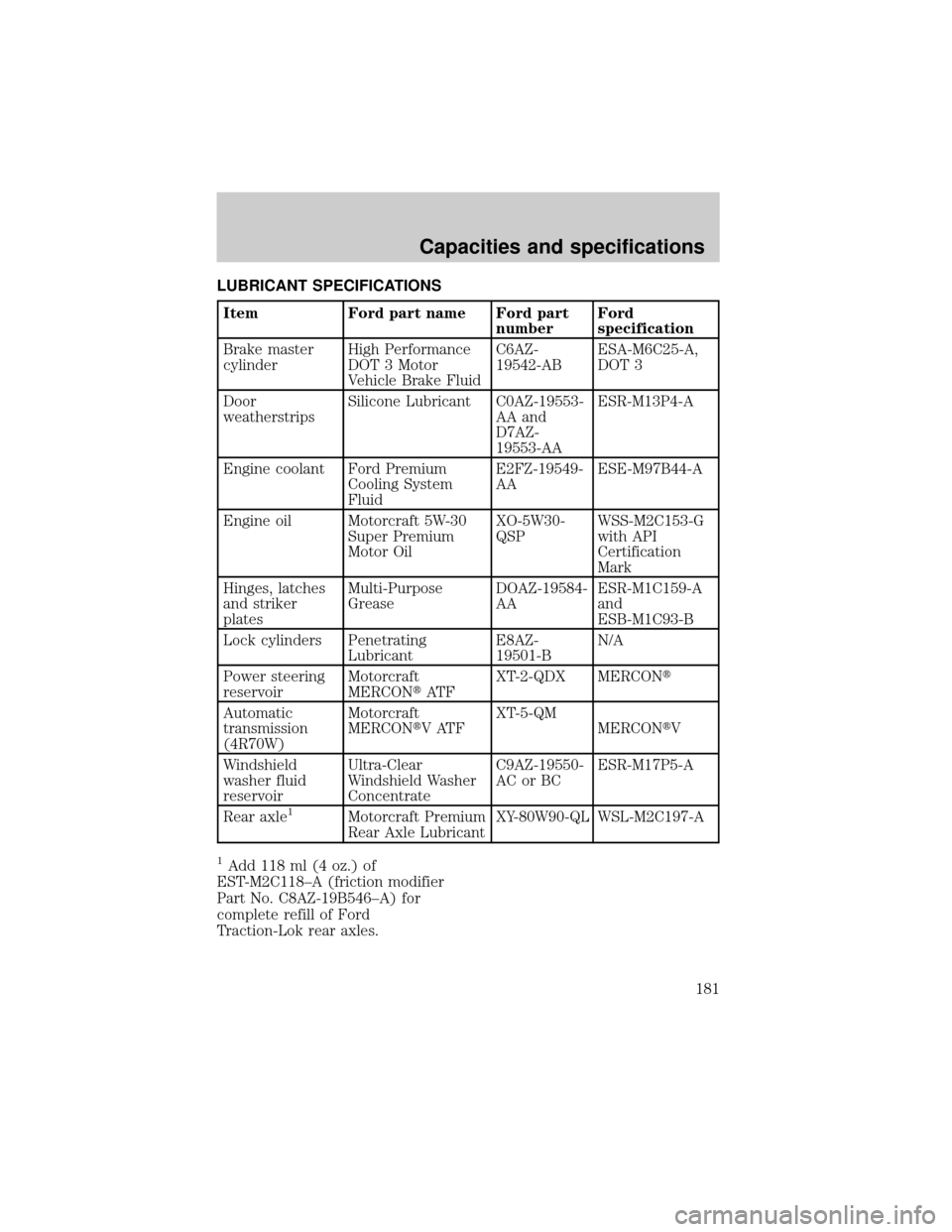
LUBRICANT SPECIFICATIONS
Item Ford part name Ford part
numberFord
specification
Brake master
cylinderHigh Performance
DOT 3 Motor
Vehicle Brake FluidC6AZ-
19542-ABESA-M6C25-A,
DOT 3
Door
weatherstripsSilicone Lubricant C0AZ-19553-
AA and
D7AZ-
19553-AAESR-M13P4-A
Engine coolant Ford Premium
Cooling System
FluidE2FZ-19549-
AAESE-M97B44-A
Engine oil Motorcraft 5W-30
Super Premium
Motor OilXO-5W30-
QSPWSS-M2C153-G
with API
Certification
Mark
Hinges, latches
and striker
platesMulti-Purpose
GreaseDOAZ-19584-
AAESR-M1C159-A
and
ESB-M1C93-B
Lock cylinders Penetrating
LubricantE8AZ-
19501-BN/A
Power steering
reservoirMotorcraft
MERCONtAT FXT-2-QDX MERCONt
Automatic
transmission
(4R70W)Motorcraft
MERCONtVATFXT-5-QM
MERCONtV
Windshield
washer fluid
reservoirUltra-Clear
Windshield Washer
ConcentrateC9AZ-19550-
AC or BCESR-M17P5-A
Rear axle
1Motorcraft Premium
Rear Axle LubricantXY-80W90-QL WSL-M2C197-A
1Add 118 ml (4 oz.) of
EST-M2C118±A (friction modifier
Part No. C8AZ-19B546±A) for
complete refill of Ford
Traction-Lok rear axles.
Capacities and specifications
181